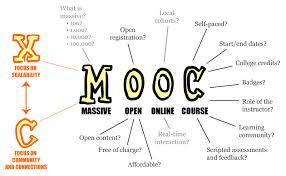https://pressbooks.bccampus.ca/teachinginadigitalagev2/chapter/section-7-5-strengths-and-weaknesses-of-moocs/Universities have a responsibility for sharing research and knowledge, not only to students and fellow researchers, but to the rest of the society. There are of course many aspects to sharing, and many ways of doing so. Articles in research magazines, and courses with tuition fees being the most common. Open Educational Resources (OER) are resources that are made for educational purposes, and that are shared openly with no cost attached. These resources usually use Creative Commons (https://creativecommons.org/about/) licenses to grant copyright permission for creative use of resources.
OER is not a new idea but a very interesting way of rethinking both knowledge sharing and education (although with some limitations).
MOOCs are one possible solution for giving access to education and research.
2012 was «The year of the MOOC» according to media

“MOOCs”, the big buzz that had yet to be discovered by most academics and universities, started, according to Bates (lenke), with Siemens, Downes and Cormier and their Course “Connective knowledge” in 2008. The really big MOOCs emerged from around 2011 and 2012 when Stanford, MIT and Harvard started developing their platforms to deliver open courses in a really big scale. (https://pressbooks.bccampus.ca/teachinginadigitalagev2/chapter/section-7-2/)
The Norwegian government appointed in June 2013 an expert group to study the opportunities and challenges that might follow from the emergence of MOOCs. Their mission was to give recommendations as to how the Norwegian Government and Norwegian institutions best could meet this trend and how they could use the opportunities given by this technological development. (Translated from Norwegian from this page)
When the expert group delivered their report in 2014, they had a number of recommendations, although not all of them connected to MOOCs. Amongst the recommendations for MOOCs in Norway were:
- closer consideration of a national platform for MOOC deliverance
- recommendations that corporations use MOOCs and similar offers for competence enhancement.
- recommend that Norwegian MOOCs should be offered free of charge as a default.
- recommends that it be considered that Norwegian students participating in MOOCs offered (also) outside of Norway be considered for economic support. (Norwegian students can get advantageous student financing through The Norwegian State Education Loan Fund).
These were early MOOC-days, and one had high expectations for what MOOCs could be. There has been some MOOC-initiatives in Norway, but most of them in Norwegian and hence not «Massive» in the sense of other MOOCs. The earliest MOOC initiative in Norway was delivered by Professor Arne Krokan at NTNU (lenke).
I started working on a “MOOC-inspired” course in 2013/14. This was an assignment given to The Norwegian Centre for ICT in Education (now part of The Norwegian Directorate for Education and Training). The assignment was, together with a couple of Universities, to create a credit giving course for Norwegian primary school teachers in need of enhancing their teaching skills in mathematics. Norwegian teacher-education institutions already offered courses for this, but they were mainly for a limited number of teachers each, and mostly a mix of seminars on campus and online resources. The Norwegian Ministry of Education and Research recognized the need for skill enhancement for a great number of mathematic teachers in a more time efficient way, hence the assignment. The course had to be online only, be scalable, demand fewer hours from the lecturers, and enhance collaboration between the students. At the same time the course had to meet the universities demands in regard to mandatory student assignments, exams and so forth. All these limitations are why we chose to call this a “MOOC-inspired” course. We had great success with both this and similar courses, delivering education to groups of 3-400 students at a time, totally online. One cannot compare this to ordinary MOOCs and the trouble they have in regard to participation and drop-out, but it is nevertheless interesting to compare this to ordinary courses for continuous education. In the case of delivering needed education more efficiently, this worked. It also worked to deliver a 100 % online course where reflection over one’s own practice plays a big role, and that was quite interesting to be a part of. This project also brought important experience in designing online learning, which have transmission value to approximately all other learning courses since all courses these days are a mix of online and campus.
The big challenge with MOOCs in regard to open education is when it comes to credit giving courses. As Bates states in his book (finn sitat og lenke) most institutions don’t (yet) recognize certificates (or micro credentials) from MOOCs (not even their own) as an entrance to their ordinary programs.
The big challenge with MOOCs in regard to open education is when it comes to credit giving courses. As Bates states in his book:
“…However, most of the institutions offering MOOCs will not accept their own certificates for admission or credit within their own, campus-based programs. Probably nothing says more about the confidence in the quality of the assessment than this failure of MOOC providers to recognize their own teaching“
(https://pressbooks.bccampus.ca/teachinginadigitalagev2/chapter/section-7-5-strengths-and-weaknesses-of-moocs/)
